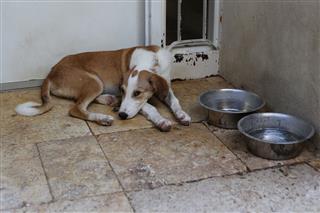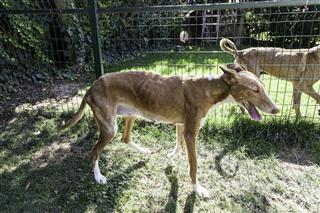
The amoxicillin side effects in dogs can be quite damaging, not to mention painful, for your pet. Find out here on how to administer this drug, and how to go easy on everyday dosage to stay clear from causing your pet unintentional harm…
When it comes to using amoxicillin, one must keep in mind that dogs and other pets that suffer from allergies or hypersensitivity, cannot use this particular drug to eradicate a problem. The issue at hand when this drug comes in, has to be associated with a bacterial infection. If your dog is under any other medication, it would do you good to make sure that amoxicillin doesn’t mix with these, thus causing an effect that could be dangerous or ineffective. Amoxicillin side effects in dogs can be witnessed over time, with damaging effects that upon seeing, should be immediately addressed for evaluation in a pet clinic.
Quick Read
- Used for: Treating bacterial infections
- Available as: Capsules (250-500 mg), Tablets (100-400 mg), Liquid form (50 mg/ml drops)
- Recommended (Common) Dosage: 5 to 12 mg/pound of your dog’s body weight
- Route of Administration: Oral
- Duration: Twice daily for 5-7 days
- Expected Side Effects: Diarrhea, vomiting or constipation
Note.- Pets allergic to antibiotic class of penicillin will naturally be allergic to amoxicillin as well. Please make sure your pet’s veterinarian is aware of this. Its Uses
The use of this drug is to treat bacterial infections, alimentary canal problems, wounds, tooth abscesses, skin infections, lower respiratory tract infections, urinary bladder problems and so on.
It cannot treat problems related to viral infections, but only those that are bacterial-related. Parasites as well if found to be the cause of a health problem, cannot be dealt with using this drug. This prescription drug is available for both dogs and humans for pretty much the same health issues. These can be given either by using oral drops or tablets/capsules, where the former is mixed with drinking water upon ingestion, and the latter just after meals. We will look into dosage amounts later on in this write-up, after looking through what it can do for a pet dog. If used the right way, this drug can do more help than harm.
Brand Names
It falls under many brand names that are used frequently in medical stores and pharmacies, like Biomox, Trimox, Beecham, Robamox-BV, Amoxil, etc.
Side Effects of Amoxicillin in Dogs
To be able to gauge how this drug works, you’d have to take your dog to the veterinarian, to have it checked out for any problems. Always make sure these are prescribed by a vet without deciding solely on giving this to your dog. Two known medicines, erythromycin and allopurinol which your dog may be on, cannot mix with amoxicillin, for fear of an adverse reaction.
Here are the side effects of amoxicillin in dogs, as well as reactions as a result of an overdose, that you need to be on the lookout for.
- Rashes
- Hives outbreak
- Diarrhea
- Neutropenia
- Anemia
- Anaphylaxis
- Labored breathing
- Acute oliguric renal failure
- Agranulocytosis
- Lymph nodes start to enlarge
- Eosinophilia
- Fever
- Leukopenia
- Vomiting
- Nausea
- Limbs or face start to swell
- Fast-paced heartbeat
- Swollen eyes
- Allergic reaction to insulin
- Thrombocytopenia
- Vocal cords can swell up including the respiratory tract, leading up to breathing problems
- Pain in the abdomen
- Problems can arise in case of interaction with certain antibiotics like tetracycline or chloramphenicol
- Loss of appetite
The Right Amoxicillin Dosage for Dogs
Amoxicillin, like I mentioned earlier, is given in either oral drops form, or tablets/capsules. The tablets/capsules come in different dose amounts ranging from 50 mg to 400 mg, where the solutions come in bottles that need to be shaken gently before it is given to the pet. Please ensure that you first seek consultation from your veterinarian before giving this to your dog, or you’d have a heap of trouble on your hands. He/she will know best when telling you how much your pet requires on a daily basis.
The desired dose of amoxicillin for dogs is 5-12 mg per pound of body weight, which is approximately 10-25 mg for every kilogram of weight. This is then given to the pet 2 times a day or depending on the dosage amount recommended by the vet. It is important to keep the medication going even if you see that your pet has recovered. Follow the directions of the vet on when and how to stop the medication to avoid the health problem from recurring. It is also crucial to gradually stop the medication and know how it is done, or else the dog’s system will reject it eventually.
Dogs are just as fragile as us humans when it comes to their health, and therefore it is ideal to take them for regular checkups and make sure that they are healthy and fit. Diseases and infections are bound to occur in a pet’s system, and it is important as owners, to make sure they get the desired treatment method done as soon as possible to avoid it from progressing into something that one cannot contain. Amoxicillin has to be given to pets only after it has been prescribed by a veterinarian and not on your own accord.
Disclaimer: Please be aware that this article is for informative purposes only. It is neither intended nor implied to be a substitute for professional medical advice.





